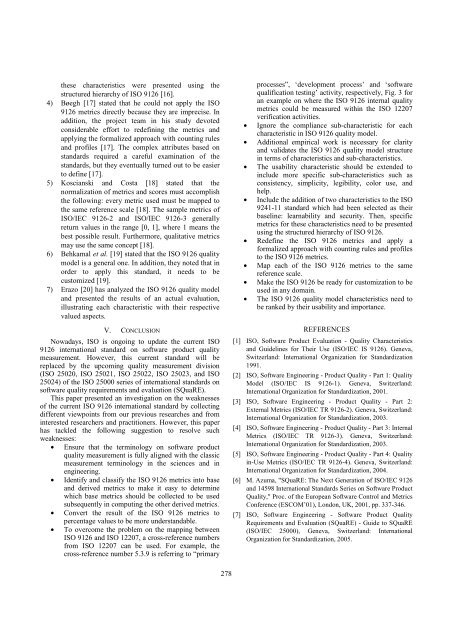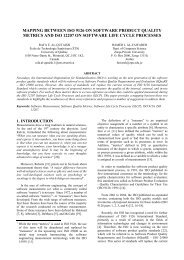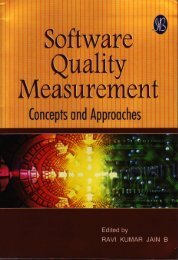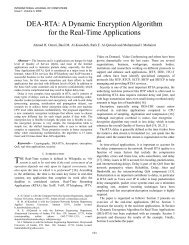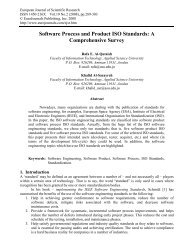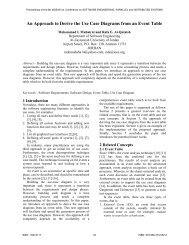An Investigation of the Weaknesses of the ISO 9126 International ...
An Investigation of the Weaknesses of the ISO 9126 International ...
An Investigation of the Weaknesses of the ISO 9126 International ...
Create successful ePaper yourself
Turn your PDF publications into a flip-book with our unique Google optimized e-Paper software.
<strong>the</strong>se characteristics were presented using <strong>the</strong><br />
structured hierarchy <strong>of</strong> <strong>ISO</strong> <strong>9126</strong> [16].<br />
4) Bøegh [17] stated that he could not apply <strong>the</strong> <strong>ISO</strong><br />
<strong>9126</strong> metrics directly because <strong>the</strong>y are imprecise. In<br />
addition, <strong>the</strong> project team in his study devoted<br />
considerable effort to redefining <strong>the</strong> metrics and<br />
applying <strong>the</strong> formalized approach with counting rules<br />
and pr<strong>of</strong>iles [17]. The complex attributes based on<br />
standards required a careful examination <strong>of</strong> <strong>the</strong><br />
standards, but <strong>the</strong>y eventually turned out to be easier<br />
to define [17].<br />
5) Koscianski and Costa [18] stated that <strong>the</strong><br />
normalization <strong>of</strong> metrics and scores must accomplish<br />
<strong>the</strong> following: every metric used must be mapped to<br />
<strong>the</strong> same reference scale [18]. The sample metrics <strong>of</strong><br />
<strong>ISO</strong>/IEC <strong>9126</strong>-2 and <strong>ISO</strong>/IEC <strong>9126</strong>-3 generally<br />
return values in <strong>the</strong> range [0, 1], where 1 means <strong>the</strong><br />
best possible result. Fur<strong>the</strong>rmore, qualitative metrics<br />
may use <strong>the</strong> same concept [18].<br />
6) Behkamal et al. [19] stated that <strong>the</strong> <strong>ISO</strong> <strong>9126</strong> quality<br />
model is a general one. In addition, <strong>the</strong>y noted that in<br />
order to apply this standard, it needs to be<br />
customized [19].<br />
7) Erazo [20] has analyzed <strong>the</strong> <strong>ISO</strong> <strong>9126</strong> quality model<br />
and presented <strong>the</strong> results <strong>of</strong> an actual evaluation,<br />
illustrating each characteristic with <strong>the</strong>ir respective<br />
valued aspects.<br />
V. CONCLUSION<br />
Nowadays, <strong>ISO</strong> is ongoing to update <strong>the</strong> current <strong>ISO</strong><br />
<strong>9126</strong> international standard on s<strong>of</strong>tware product quality<br />
measurement. However, this current standard will be<br />
replaced by <strong>the</strong> upcoming quality measurement division<br />
(<strong>ISO</strong> 25020, <strong>ISO</strong> 25021, <strong>ISO</strong> 25022, <strong>ISO</strong> 25023, and <strong>ISO</strong><br />
25024) <strong>of</strong> <strong>the</strong> <strong>ISO</strong> 25000 series <strong>of</strong> international standards on<br />
s<strong>of</strong>tware quality requirements and evaluation (SQuaRE).<br />
This paper presented an investigation on <strong>the</strong> weaknesses<br />
<strong>of</strong> <strong>the</strong> current <strong>ISO</strong> <strong>9126</strong> international standard by collecting<br />
different viewpoints from our previous researches and from<br />
interested researchers and practitioners. However, this paper<br />
has tackled <strong>the</strong> following suggestion to resolve such<br />
weaknesses:<br />
• Ensure that <strong>the</strong> terminology on s<strong>of</strong>tware product<br />
quality measurement is fully aligned with <strong>the</strong> classic<br />
measurement terminology in <strong>the</strong> sciences and in<br />
engineering.<br />
• Identify and classify <strong>the</strong> <strong>ISO</strong> <strong>9126</strong> metrics into base<br />
and derived metrics to make it easy to determine<br />
which base metrics should be collected to be used<br />
subsequently in computing <strong>the</strong> o<strong>the</strong>r derived metrics.<br />
• Convert <strong>the</strong> result <strong>of</strong> <strong>the</strong> <strong>ISO</strong> <strong>9126</strong> metrics to<br />
percentage values to be more understandable.<br />
• To overcome <strong>the</strong> problem on <strong>the</strong> mapping between<br />
<strong>ISO</strong> <strong>9126</strong> and <strong>ISO</strong> 12207, a cross-reference numbers<br />
from <strong>ISO</strong> 12207 can be used. For example, <strong>the</strong><br />
cross-reference number 5.3.9 is referring to “primary<br />
processes”, ‘development process’ and ‘s<strong>of</strong>tware<br />
qualification testing’ activity, respectively, Fig. 3 for<br />
an example on where <strong>the</strong> <strong>ISO</strong> <strong>9126</strong> internal quality<br />
metrics could be measured within <strong>the</strong> <strong>ISO</strong> 12207<br />
verification activities.<br />
• Ignore <strong>the</strong> compliance sub-characteristic for each<br />
characteristic in <strong>ISO</strong> <strong>9126</strong> quality model.<br />
• Additional empirical work is necessary for clarity<br />
and validates <strong>the</strong> <strong>ISO</strong> <strong>9126</strong> quality model structure<br />
in terms <strong>of</strong> characteristics and sub-characteristics.<br />
• The usability characteristic should be extended to<br />
include more specific sub-characteristics such as<br />
consistency, simplicity, legibility, color use, and<br />
help.<br />
• Include <strong>the</strong> addition <strong>of</strong> two characteristics to <strong>the</strong> <strong>ISO</strong><br />
9241-11 standard which had been selected as <strong>the</strong>ir<br />
baseline: learnability and security. Then, specific<br />
metrics for <strong>the</strong>se characteristics need to be presented<br />
using <strong>the</strong> structured hierarchy <strong>of</strong> <strong>ISO</strong> <strong>9126</strong>.<br />
• Redefine <strong>the</strong> <strong>ISO</strong> <strong>9126</strong> metrics and apply a<br />
formalized approach with counting rules and pr<strong>of</strong>iles<br />
to <strong>the</strong> <strong>ISO</strong> <strong>9126</strong> metrics.<br />
• Map each <strong>of</strong> <strong>the</strong> <strong>ISO</strong> <strong>9126</strong> metrics to <strong>the</strong> same<br />
reference scale.<br />
• Make <strong>the</strong> <strong>ISO</strong> <strong>9126</strong> be ready for customization to be<br />
used in any domain.<br />
• The <strong>ISO</strong> <strong>9126</strong> quality model characteristics need to<br />
be ranked by <strong>the</strong>ir usability and importance.<br />
REFERENCES<br />
[1] <strong>ISO</strong>, S<strong>of</strong>tware Product Evaluation - Quality Characteristics<br />
and Guidelines for Their Use (<strong>ISO</strong>/IEC IS <strong>9126</strong>). Geneva,<br />
Switzerland: <strong>International</strong> Organization for Standardization<br />
1991.<br />
[2] <strong>ISO</strong>, S<strong>of</strong>tware Engineering - Product Quality - Part 1: Quality<br />
Model (<strong>ISO</strong>/IEC IS <strong>9126</strong>-1). Geneva, Switzerland:<br />
<strong>International</strong> Organization for Standardization, 2001.<br />
[3] <strong>ISO</strong>, S<strong>of</strong>tware Engineering - Product Quality - Part 2:<br />
External Metrics (<strong>ISO</strong>/IEC TR <strong>9126</strong>-2). Geneva, Switzerland:<br />
<strong>International</strong> Organization for Standardization, 2003.<br />
[4] <strong>ISO</strong>, S<strong>of</strong>tware Engineering - Product Quality - Part 3: Internal<br />
Metrics (<strong>ISO</strong>/IEC TR <strong>9126</strong>-3). Geneva, Switzerland:<br />
<strong>International</strong> Organization for Standardization, 2003.<br />
[5] <strong>ISO</strong>, S<strong>of</strong>tware Engineering - Product Quality - Part 4: Quality<br />
in-Use Metrics (<strong>ISO</strong>/IEC TR <strong>9126</strong>-4). Geneva, Switzerland:<br />
<strong>International</strong> Organization for Standardization, 2004.<br />
[6] M. Azuma, "SQuaRE: The Next Generation <strong>of</strong> <strong>ISO</strong>/IEC <strong>9126</strong><br />
and 14598 <strong>International</strong> Standards Series on S<strong>of</strong>tware Product<br />
Quality," Proc. <strong>of</strong> <strong>the</strong> European S<strong>of</strong>tware Control and Metrics<br />
Conference (ESCOM’01), London, UK, 2001, pp. 337-346.<br />
[7] <strong>ISO</strong>, S<strong>of</strong>tware Engineering - S<strong>of</strong>tware Product Quality<br />
Requirements and Evaluation (SQuaRE) - Guide to SQuaRE<br />
(<strong>ISO</strong>/IEC 25000), Geneva, Switzerland: <strong>International</strong><br />
Organization for Standardization, 2005.<br />
278


